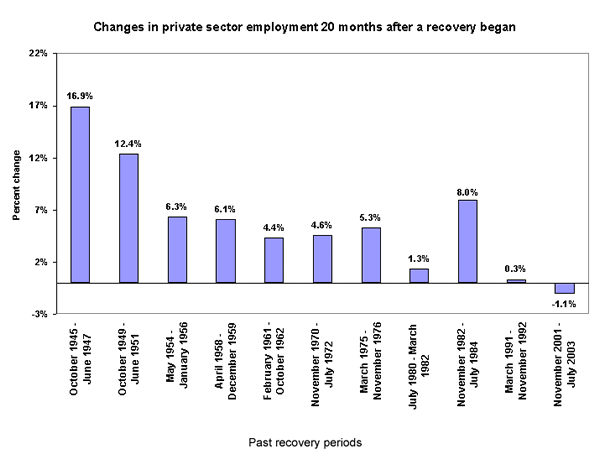August 1, 2003
Dip in jobless rate, yet hiring slump persists
The nation’s unemployment rate fell to 6.2% in July, though payrolls continued to contract, falling by 44,000, according to today’s report from the Bureau of Labor Statistics (BLS). The fall in unemployment was largely driven by a drop of 556,000 in the labor force, and thus is not indicative of an improvement in the labor market (employment actually fell in the survey from which the unemployment rate is derived). In fact, hours worked per week, a measure of the strength of labor demand, fell to the lowest level on record (tracking began in 1964). Despite some positive indicators of renewed economic activity, the nation remains mired in a deep and persistent hiring slump.
June’s job losses were revised down from 30,000 to 72,000, and outside of a few sectors, employers continued to cut jobs in July. Since the recession began in March 2001, payrolls are down by 2.7 million overall and 3.2 million in the private sector. Since the business cycle expansion began in November 2001, payrolls have contracted by one million (1.2 million in the private sector), making this the weakest recovery in terms of employment since the BLS began tracking monthly data in 1939 (see graph).

Manufacturing again posted the largest drop—employment in the nation’s factories was down 71,000 in July, though the BLS noted that part of the decline was due to an unusual seasonal factor in autos. However, manufacturing losses were widespread, with losses in both durables (e.g., metals, computers, computers, machinery) and nondurables (apparel and textiles). Since the recession began, manufacturing payrolls have fallen by 2.3 million, by far the largest loss for any sector of the labor market. As a share of total employment, manufacturing is down from 13% to 11%, a remarkable shift in the composition of employment over a relatively short time.
The service sector added 23,000 jobs, led by a significant jump in temporary hiring, which was up 42,000 in July and 122,000 since April 2003. This increase indicates that, while the expansion is leading to new hires in business services, employers are not willing to commit to a larger permanent workforce until they become more confident in the strength of the recovery.
The decline in unemployment was, in part, due to fewer people competing for scarce jobs as the labor force contracted by over half-a-million. On a monthly basis, this is a volatile statistic—last month the labor force grew by more than this amount. However, along with other indicators, it can be taken as a sign that some potential job seekers have given up looking for work for the time being and thus are not counted among the unemployed.
A more comprehensive measure of labor market distress is the underemployment rate, which adds various categories of under-utilization to the unemployment rate, including discouraged workers and those working part time who would prefer full-time jobs (this latter group grew by 150,000 last month and is up 41% since the recession began). The underemployment rate was 10.2% last month, four percentage points higher than the less-comprehensive unemployment rate (note that underemployment is seasonally adjusted by EPI and is not an official BLS statistic).
Another indicator of the lack of jobs is the increase in long-term unemployment. In July, the share of job-seekers who have looked for work for at least 15 weeks rose to 39.8%, the highest level since July 1983, when the unemployment rate was 9.4%.
The persistence of weak demand for workers has taken its toll on hours and wage growth as well. As noted, the average hours of production workers in manufacturing and non-supervisors in services fell to 33.6 hours per week, the lowest level since collection of those data began in 1964. Hourly wages are also growing more slowly now, implying that weekly earnings have decelerated due to both declining hours and slowing wage growth. Averaging over the past three months, quarterly weekly earnings are growing at an annual rate of 1.8%, a rate that is below even the low level of inflation in recent months. Thus, many workers are losing ground in real terms.
Recent economic reports, including yesterday’s better-than-expected gross domestic product report for the second quarter, suggest the economy is gaining strength. While this is likely the case, the expansion has clearly not reached the labor market. The main reason is that growth is still too weak to generate net job gains or persistent declines in unemployment. For that to occur, the economy needs GDP growth to stay above 3% for many quarters running (GDP grew 2.4% in the second quarter, but 70% of that growth was attributable to federal spending on defense fueled by the war in Iraq).
This slow-growth dynamic will continue to constrain the nascent recovery. The weakness in the labor market is clearly reducing the growth of earnings, meaning consumers, most of who depend on their paychecks, are likely to remain insecure about where the economy is headed. This in turn has the potential to constrain consumption growth, limiting the boost that the economy will get from the recent tax cut, and delaying the arrival of a truly self-sustaining recovery.
—Jared Bernstein
with research assistance by Sujan Vasavada
The Economic Policy Institute JOBS PICTURE is published each month upon release of the Bureau of Labor Statistics’ employment report.
